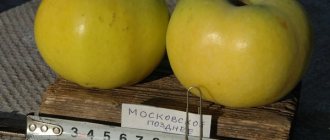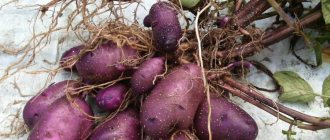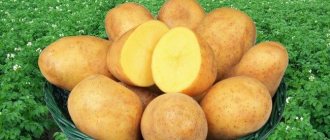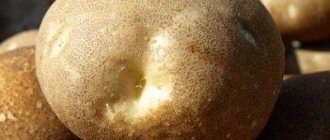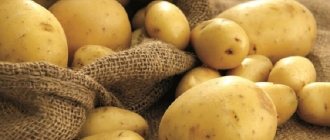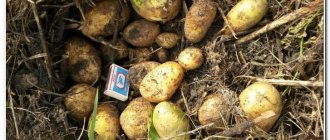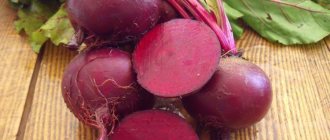Characteristics of the Kolobok potato variety
The yellow-fruited variety is characterized by medium ripening periods. The tubers, with their characteristic rich yellow flesh and skin, have a slightly elongated round shape with pronounced but shallow eyes. The skin is very dense, so the crop can be stored for a long time and transported over long distances without loss. Photos and descriptions of the Kolobok potato variety indicate that this is a very attractive crop that is in high demand among ordinary gardeners and farmers who grow vegetables for sale.
The average weight of potatoes is 120-140 g. They ripen from the moment of planting in 90-115 days. 1 potato bush of the Kolobok variety produces an average of 15-18 tubers. The tops do not stretch upward too much. The crown is formed semi-erect. The leaves are usually medium in size, sometimes large, and light green in color. Flowering is usually abundant, the flowers are very light - larger than usual. A distinctive feature is the evenness of the tubers in relation to each other; very few non-marketable potatoes of irregular shape and too small size grow.
Correct fit
Basic landing rules:
- Planting is carried out in May, in completely heated soil;
- Pre-planting tubers are treated and treated with a growth stimulator;
- The distance between the bushes should be from 30 to 35 cm, the row spacing should be left wide to facilitate further care. Planting material is buried 10 cm.
REFERENCE: For growing, give preference to light sand-based soil.
Taste qualities of potatoes
Consumers rate the taste of Kolobok potatoes as pleasant. According to reviews, it is good for chips and French fries. If we are talking about processing large volumes of tubers, then they are more often used to produce dry puree and frozen vegetable mixtures. The starch content typical of the Kolobok potato variety is no more than 15%. In general, the purpose is universal. When cooked, the pulp usually does not darken, does not boil too much, remaining dense. Therefore, it is recommended to fry the tubers.
Excellent reviews and characteristics of the Kolobok potato variety have made it a real bestseller. The demand for its seeds is very high.
Collection, storage and use of crops
Mass harvest of Kolobok potatoes begins 95-115 days after planting. It is advisable to dig it up on a warm, dry day. It is allowed to use a motor cultivator and other equipment.
After harvesting, the potatoes are laid out in a dry, bright place to dry. It is recommended to carry out sorting, setting aside seed, table and damaged material in separate groups.
Important! Medium Kolobok tubers are chosen for seeds - they are more resistant to pests and diseases.
After drying, the potatoes are stored in a cellar or basement. It is better to put it in wooden boxes, pre-treated with a solution of potassium permanganate. The optimal temperature for storage is about +10-12°C, humidity is no more than 85%.
The bun is perfect for preparing any dishes, including fried potatoes, chips and french fries, as it holds its shape perfectly.
Pros and cons of the Kolobok potato variety
Among the advantages of the Kolobok variety:
- delicate taste;
- keeping quality;
- stable yield;
- unpretentiousness to growing conditions;
- versatility of use;
- resistance to diseases.
The only drawback that can be noted is the need for watering. In the absence of the required amount of moisture, the yield of the Kolobok potato variety can fluctuate by almost 2 times. They also note a very dense peel, which is more difficult to cut off during peeling than other varieties. This is invariably noted when describing Kolobok potatoes, because hard skin is a distinctive feature of potatoes harvested by mechanization.
Advantages and disadvantages
The Kolobok variety has a number of advantages and benefits that are highly valued by both private owners and farm specialists. The positive qualities of yellow potatoes include:
- Its high yield and very pleasant taste.
- Remarkable commercial (or industrial) qualities.
- Low starch content.
- Almost identical tuber sizes.
- Unpretentiousness when growing and caring.
- Insensitivity to prolonged germination in the same place.
- Immunity to most garden pests and diseases.
- Excellent keeping quality and good transportability.
The disadvantages of potatoes of this variety include increased sensitivity to the quality and variety of fertilizing and the need to maintain a given level of soil moisture. Some users do not like its too dense peel, which significantly complicates the process of cleaning the tubers.
Potatoes with the culinary name Kolobok are considered a promising and high-yielding species, quite suitable for commercial cultivation. Most users appreciate it for the neat appearance of yellow tubers, as well as for its immunity to various diseases and its unique flavor.
Planting and caring for Kolobok potatoes
The optimal planting time is in the first ten days of May. The main condition is that the soil has completely thawed and warmed up to at least + 10 0C.
Selection and preparation of a landing site
Areas for potato planting have been prepared since the fall. Carefully remove all plant debris and roots of perennial weeds. If potatoes have already been planted in a given area this year, it is not recommended to use them for this next year. Crop rotation is at least 3 years. Optimal predecessors are legumes, cruciferous vegetables and spicy greens.
When digging up a site in the fall, organic fertilizers are added to the soil: mullein, bird droppings, compost. In the spring, the digging is repeated, the soil is harrowed, and a portion of complex mineral fertilizer or well-rotted manure is added. Then the rows are marked.
Preparation of planting material
Tubers for planting must not only be well dried and free from traces of diseases, mold, and fungi, but also be pickled. If there is a delay in sowing due to weather conditions, it is recommended to treat the planting material with a growth stimulant. A week before the expected planting date, the boxes with tubers are placed in a warm place to stimulate the growth of shoots from the eyes. The sprouts should not be too large, as then they will break off when planted.
Landing rules
The following planting scheme is recommended for the Kolobok potato variety:
- 60 cm between rows;
- 30 cm between individual bushes.
It is best to orient the rows from north to south to provide the plantings with optimal illumination. Along with each tuber, it is recommended to throw in a large handful of wood ash, as well as a handful of manure or compost.
Advice! Experienced gardeners recommend throwing onion peels into the holes to protect Kolobok and other potatoes from the Colorado potato beetle.
Watering and fertilizing
It is recommended to water the Kolobok potato plantings at least once a week. Lack of moisture has a negative impact on crop yields. Can be combined with fertilizing. It is recommended to do them on average 2-3 times throughout the entire season, giving preference to potash ones. Nitrogen fertilizers are abandoned, as they lead to the growth of tops, but not tubers.
The recommendations of gardeners are clear: if there is a choice, then preference should always be given to organic fertilizers. They have a positive effect on the taste of tubers. The use of chemical fertilizers worsens the taste of potatoes.
It is very important to provide watering until the end of flowering. After this, the lack of rain and drought will no longer cause critical damage to the harvest. The Kolobok potato variety invariably pleases with its productivity, but only with sufficient moisture of the plantings from the emergence of seedlings to the forcing of buds.
Loosening and weeding
These events are combined. The frequency of weeding depends on the weed infestation of the area. Typically, the beds are inspected every week, and the rows are weeded if necessary. It is important to prevent the growth of powerful plants (sow thistle, wheatgrass, etc.) with strong roots. They can pierce tubers and significantly spoil the harvest.
Hilling
It is recommended to hill in 2 steps. The first time Kolobok potatoes are spudded when the bushes grow to 20 cm in height. After 3 weeks, the work is repeated again. After each procedure, be sure to carry out abundant watering. It is best when hilling is carried out before flowering, since abundant watering can provoke the appearance of late blight on adult bushes.
Under no circumstances should you refuse hilling. It is a mistake to believe that they are performed only to preserve moisture in the soil. In fact, thanks to this operation, the bushes are formed correctly. If you leave the planting without hilling, the stems will soon fall and may even break.
Features of cultivation
The agricultural technology is simple: planting begins in May, when the soil has completely warmed up. Before sowing, the tubers are pickled and can be treated with a growth stimulant. The variety is sensitive to soil nutrition; light sand-based soil is preferred. Tubers are planted with a depth of 10 cm, the distance between bushes is 30-35 cm . Wide row spacing is required to facilitate plant care.
During the season, plants are fed 2-3 times, alternating potassium-based mineral complexes and organic matter (mullein or bird droppings).
You should not overuse nitrogen-based fertilizers (urea or ammonium nitrate). Plants will begin to actively gain green mass to the detriment of the development of root crops.
When organizing feeding, you should observe moderation . Excess nutrients contribute to the accumulation of nitrates. Read more about what to feed potatoes, when and how to apply fertilizers, and how to do it correctly when planting.
For optimal hydration, it is recommended to organize drip irrigation. If this is not possible, during dry summers the plantings are watered in the usual way. Potatoes tolerate short-term drought without consequences , but a constant lack of moisture will have a detrimental effect on the harvest. Hilling and mulching will help regulate humidity and fight weeds.
Drying plant stems will be the signal for the start of harvesting. The first tubers can be dug up in mid-summer , but the variety reaches its maximum yield by the second decade of September. Before digging, you should cut off all the tops. After digging, the potatoes are sorted and laid out to dry.
Seed material is collected and stored separately. Only smooth, healthy tubers without damage can be used as a seed fund.
Agricultural technology for growing potatoes has certain subtleties. In addition, there are different ways to obtain the harvest. On our website you will find useful information about growing potatoes in bags and barrels, in boxes and under straw. And also everything about Dutch technologies.
Diseases and pests
The Kolobok potato variety is resistant to scab, cancer, and viral diseases. Late blight and cyst nematodes are found on bushes. To protect against them, targeted drugs are used. Treatments are carried out once or twice, no more, and no later than 3 weeks before harvest.
The Kolobok potato is defenseless against the Colorado potato beetle. You can use special preparations for it, or if the infestation is not too high, use manual collection of beetles and larvae. They should not be fed to poultry or livestock, only destroyed.
Pest control
The greatest damage to Kolobok potatoes is caused by the Colorado potato beetle, wireworm and aphid. The larvae of the Colorado potato beetle eat the leaves, thereby reducing the yield, the wireworm spoils the tubers by making tunnels in them, and the aphid sucks the juices from the plants, which leads to spotting and curling of the leaves, and this also negatively affects the future harvest. Insecticides will help destroy pests; they must be used strictly according to the instructions.
If you cannot do without chemicals in the fight against aphids, then the Colorado potato beetle can be dealt with using traditional methods. In small areas, insects are collected by hand and then destroyed outside the garden.
How to store Kolobok potatoes
Dry basements are suitable for preserving the potato harvest. Light is not required; it stimulates the greening of tubers and active growth of shoots. Recommended temperature is about + 4 0C, humidity is about 60-70%. The tubers are laid out in wooden boxes. The keeping quality of Kolobok potatoes is very good, thanks to the thick and tough skin. It is perfectly preserved until the next harvest.
The selection of seed tubers is carried out immediately after the crop has been dug up and well dried under a canopy in the fresh air. Small but regularly shaped tubers without mechanical damage or signs of disease are selected for planting.
Excessive humidity and heat have a detrimental effect on stored potatoes. It is recommended to rinse the container in which the crop will be stored thoroughly with a solution of potassium permanganate. You should also make sure that the basement has good ventilation.
Agricultural technology
Preparation and transfer to the ground
Potatoes of this variety adapt well to a wide variety of soils, but adapt best to light soils. Before planting, you will need to select intact medium-sized tubers.
Before planting, pre-sorted tuber preparations are germinated in the light until shoots about 2-3 cm long appear.
The area on which this type of potato is planted should be prepared in advance: by carefully digging it up and fertilizing it in the fall. With the arrival of spring, it is enough to dig up the beds again and clear them of weeds, then add phosphorus and potassium fertilizers to the loose soil.
Fashionable denim vests 2021: photos of new products, what to wear with them in the fall-winter season
To speed up the maturation process, it is enough to follow these simple rules:
- Before planting the prepared material, you must wait until the soil at the planting depth (10-12 cm) warms up to at least +8 degrees.
- In terms of time, these procedures should be tied to the first half of May, when the eyes of the blanks slightly begin to sprout.
- The soil prepared for planting should be moderately moist.
- The planting itself is carried out in rows located along a linear north-south axis, which will provide future plants with acceptable sunlight.
- If groundwater is close, planting should be done in beds slightly elevated above ground level.
- The gap left between the rows should allow you to easily care for the growing bushes (for this it is taken to be at least 60 cm).
- The planting step for potato nests is usually about 30-35 cm.
It is best to plant potatoes in the first half of May.
When planting, add a small handful of ash and about the same amount of compost or humus to each hole. Some potato growers replace them with a mixture of organic fertilizers applied at the rate of about 20 grams per nest.
Features of care and collection
Caring for potatoes of this variety comes down to their hilling, fertilizing and abundant watering, organized during the formation of the ovaries. Loosening the soil should be done three times during the growing season, namely:
- First, when the height of the bushes reaches 25 cm.
- The second time they spud in about 2-3 weeks.
- Another loosening is organized approximately 24 days before harvesting.
At the end of the flowering period, watering potatoes is undesirable, since an abundance of moisture can threaten late blight. During the entire growing season, 2-3 feedings of the nests of the growing plant are also carried out using potassium supplements mixed with droppings or mullein. To avoid drying out of the soil during this period, another hilling with simultaneous mulching is organized.
A sign of the ripening of plant tubers is the complete drying of its stems, which are most often cut off in the form of tops for ease of harvesting. After this, the potatoes are dug up and placed in one row under a canopy to dry.
Drying of the tops is a sign of potato ripening
Reviews about the Kolobok potato variety
Veronika Igoreva, 44 years old, Voronezh
I have been planting the Kolobok potato variety for many years in a row. I prefer to buy seeds rather than take my own. This way the result is better, but it’s not a fact that he will grow up without diseases. If the seeds are good, then 14 tubers are guaranteed from each bush. At most, I used to collect 18 pieces. Watering is also important, I make sure to water it once a week, otherwise the tops will become skinny and the tubers will become smaller. I recommend this variety as reliable and tasty.
Alexander Ivanchenko, 50 years old, Shakhty
I grow potatoes for sale, so I select varieties meticulously. I take those that are stored well. It is important not only to grow. But also sell. During the season the price is low, but as spring approaches it is different. Kolobok is a variety with excellent keeping quality. It’s spring, and it’s juicy, dense, doesn’t wither or spoil. There are varieties that are more productive, but they are stored worse. That’s why I treat Kolobok very well and advise everyone to plant it.
Is it worth choosing? Farmer reviews
- Those who have just started growing the Kolobok potato variety and those who have had it in their garden for a long time are equally satisfied with this variety. The tubers have a pleasant round shape, with a durable, slightly rough skin that is easy to remove with a knife.
- If you mash potatoes, they will turn out crumbly and have a nice creamy color. This is due to the fact that tubers contain a lot of starch. This variety has excellent shelf life and potatoes can be stored in a cool place all winter without any problems.
- Vegetable growers who purchased seeds warn that you need to choose quality ones, otherwise the harvest may be bad. You can ask friends who grow this variety where they got the seeds or buy them from them.
Reviews from gardeners
Novikova Irina, 49 years old, from Lipetsk
We plant gingerbread regularly. Potatoes are delicious. Looks great. It sits in the cellar all winter without any problems. The plant is unpretentious when grown. It is enough to hill it several times during the season, water it, apply fertilizers and there will be an excellent harvest. From 1 bush you can collect from 14 to 18 nice round potatoes. Get this variety - you won’t regret it!
Volkov Anatoly, 52 from Ivanovo
I have been growing potatoes of this variety for sale for 2 years. I've tried different varieties before. Kolobok has an excellent presentation and a high yield. There is little loss during storage. Ordinary agricultural technology. There were no particular difficulties. Consumers love the taste of this variety and the fact that it is versatile.
Mashkova Ekaterina, 46 years old, from Astrakhan
I bought Kolobok potatoes. The tubers are pleasant, smooth to the touch and one to one. I boiled potatoes in their jackets and look festive on the table with salads. I liked that the Kolobok puree is light; if you make it medium thick, it won’t crumble. The plants were irrigated by drip. There were no problems. Our bun has been growing for 2 years in a row, we are happy.
Vladimir Korneev, 63, from Tambov
I change potato varieties, planting 2 or 3 new varieties every year. This year we are growing Kolobok for the first time. I liked the light tubers. We took care of the bushes, as always, and the harvest was excellent! The bun is tasty, has excellent shelf life, grew without additional feeding, with moderate watering. Everything worked out well, I will plant it next season.
